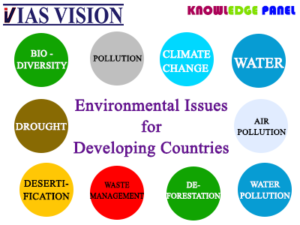ENVIRONMENT ISSUES & CLIMATE CHANGE FOR DEVELOPING COUNTRIES
CLIMATE DEBATE
ENVIRONMENT ISSUES & CLIMATE CHANGE FOR DEVELOPING COUNTRIES
World is grappling with rising temperature & since 1992 the focus has been on reducing greenhouse gas emissions, particularly carbon di oxide.
Post 1992, UNFCCC started discussion to evolve concensus TOWARDS REDUCING reducing greenhouse gas concentrations in the atmosphere to "a level that would prevent dangerous anthropogenic interference with the climate system".

From KYOTO protocol to PARIS agreement, following is the position of developing countries:
Unequal sharing of pain – developing countries produce 5 CO2 per capita as compared to developed countries who produce between 15-25 CO2 per capita. If equal burden is put for reduction in emission on developed and developing countries then they will have to reduce development targets and thereby pursuing prosperity.
As far as comparison grows average person in the US emits more than twice as much as someone living in China, five times more than one in Mexico and eight times more than one in India.
Historically economic growth and emissions growth have remained unidirectional.
Till such time as prosperity can be decoupled from CO2 emissions by proper development of technology, developing countries want liberty to keep developing by using existing technology and thereby carry on CO2 emissions.
Developed countries must accelerate the pace of their per capita reductions and developing countries must receive the technological and financial support necessary to transition towards green, low-carbon development trajectories.
Following are issues of environment concern for developing countries:
- Financing global GHG emission cuts in developing countries through finance by developed countries – buyers of carbon credits pay developing countries to offsetbe permitted to emit a certain amount of carbon dioxide or other greenhouse gases. One credit permits the emission of one ton of carbon dioxide or the equivalent in other greenhouse gases.
carbon credit system say that it leads to measurable, verifiable emission reductions from certified climate action projects, and that these projects reduce, remove, or avoid greenhouse gas (GHG) emissions.
- Negotiators at the Glasgow COP26 climate change summit in November 2021 agreed to create a global carbon credit offset trading market.
- Technological support by developed countries – developing countries bear a disproportionate burden of climate change. Pollution somewhere leads to problems elsewhere. To transition to clean energy, developing countries want technology to carry out smooth transition.
- Supporting biodiversity conservation --- developing countries are bound by international laws and conventions to conserve biodiversity but they do not have resources fulfill commitments & expect to share the burden.
- Mitigating effects of climate change – developing countries fight to control. deforestation and rising sea levels every year, leading to a heavy economic cost. It is expected that developed countries support them in terms of technology and financing.
- Technological support to fight depleting marine resources – since a lot of developing countries derive a lot of their incomes from sea. Climate change, overfishing, polluting sea lanes during transportation poses a serious challenge. It is expected that developed countries would abide by the laws and conventions to reduce impact of changing sea environment so crucial to survival of coastal societies and towards creation of a robust related economy such as tourism..
